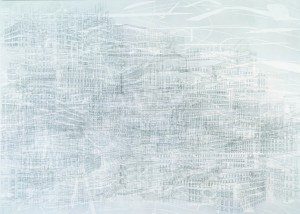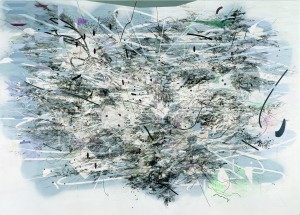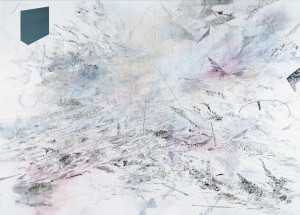
Julie Mehretu, "Berliner Plätze," 2008–09. Ink and acrylic on canvas, 304.8 x 426.7 cm Commissioned by Deutsche Bank AG in consultation with the Solomon R. Guggenheim Foundation for the Deutsche Guggenheim, Berlin
In her large, complicated paintings, Ethiopian-American artist Julie Mehretu has blended everything from historic ruins to plans for sports arenas into her rich canvases in ways that make identifying individual elements sometimes difficult. She works with layers both in terms of ideas as well as of paint and other media. Beginning with a gesso base, Mehretu adds an architectural sketch along with flat colored shapes on top of it. Then comes a layer of drawings in ink and acrylic paint after which she smoothes the surface of the canvas by sanding it down. By layering, Mehretu is not only inserting visual content into her work, but she is also simultaneously losing and obscuring some information in the process.

Julie Mehretu, "Middle Grey," 2007–09 Ink and acrylic on canvas, 304.8 x 426.7 cm Commissioned by Deutsche Bank AG in consultation with the Solomon R. Guggenheim Foundation for the Deutsche Guggenheim, Berlin
The Guggenheim Museum in New York is currently exhibiting Julie Mehretu: Grey Area, composed of six semi-abstract paintings Mehretu was commissioned to make in 2007 by Deutsche Bank and the Solomon R. Guggenheim Foundation. Thanks to this commission, Mehretu was able to rent studio space in Berlin and hang her canvases together, working on them at the same time. As a result, they dialog with each other and within the theme of the show’s title, Grey Area. Though cities may be the large topic of the paintings, Berlin takes center stage. In Berliner Platz, she seemingly forgets the modern-day city and depicts the city’s buildings as they may have looked 100 years ago, effacing Berlin’s less than attractive modern history.

Julie Mehretu, "Atlantic Wall," 2008–09. Ink and acrylic on canvas, 304.8 x 426.7 cm Commissioned by Deutsche Bank AG in consultation with the Solomon R. Guggenheim Foundation for the Deutsche Guggenheim, Berlin
Unlike many contemporary artists, Mehretu doesn’t shy away from naming her paintings. While her titles typically refer to the content of the work, they can also contribute fodder for discussion of what viewers are seeing within her painted and drawn webs. Though Middle Grey has perhaps the most generic title of the bunch, it is the show’s most intense picture. It contains the strongest use of color here and Mehretu’s drawings take a back seat to swaths of black paint, fields of color, and incongruous shapes. On the contrary, Atlantic Wall refers to something quite substantial from history: the bunkers that Germany built along the northwestern coastline in the Second World War, some of which can be found in the painting. This piece features light washes of pale, muddy color evoking a sun setting in the sky with lines and small markings. During a recent visit to the museum, I heard people debating the meaning of this piece’s name—could it refer to the dominance of the East Coast in the United States? Or evoke Mehretu’s immigration flight? My incorrect guess was something having to do with the Berlin Wall. In any event, the works seem to engage while offering no clear answers.



